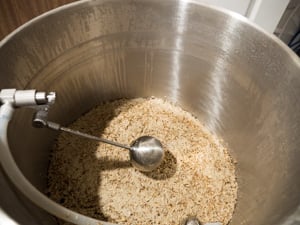
This week I take a look at the process of lautering or sparging your all grain beer. What appears to be a simple process actually has some interesting complexities to it.
Lautering
Lautering would appear to be one of the simplest steps in all grain brewing. Hot water is run through the grain bed to extract wort. Then we boil the wort, chill it and ferment it into beer. However, there are a few things going on under the hood that you need to know about.
When we talk about lautering, often brewers use the term mash efficiency. Mash efficiency is the efficiency of the overall mashing process in extracting gravity points from the grains and getting them into the wort. A related term, called brewhouse efficiency, is also used though brewhouse efficiency includes all losses going into the fermenter, instead of into the boil.
Maximizing mash efficiency depends on several factors including the malt used, grain crush, mash temperatures used, pH, as well as your lauter tun design.
Lauter Tun Design
While lautering is usually done in the mash tun, the design of the vessel can have a big impact on your mash efficiency. Ideally we want to extract as much of the color and sugars from the crushed grains as possible. We want a lauter tun that maximizes mash tun efficiency.
The grain bed is composed of particles of the inner grain seed and husks. The husks form a filter bed, so when crushing the grains we want to preserve large pieces of the husk while crushing the interior of the seed to a high degree. That is why double roller mills have become the standard for crushing brewing grains. The two rollers crush the interior of the grain but leave large pieces of husk alone to aid in filtering.
One consideration in design is the height and width of the grain bed. If the grain bed is wide but not deep, water will flow through only a thin layer of grains and not much will be extracted. While a tall grain bed might therefore seem ideal, if the bed is too tall it actually will compact the grains resulting in lower extraction.
The rule of thumb for home-sized units is that the height to width of a vessel should be between 1:2 and 2:1 (John Palmer, How to Brew, Chap 17). For a cylider this means your mash tun diameter and height should be about the same if it was filled to the top with grains. In practice often the height is a bit higher to account for deadspace and varying amounts of grain.
Another factor in lauter tun design is the flow of the wort through the grain bed, and in particular the filtering system at the bottom of the vessel. While the grain husks aid in filtering, channels still form in the bed where it is easier for the water to flow.
This is also true of the vessel filtering system. If we imagine a lauter tun with only a single small hole at the bottom to act as a filter, clearly you will get major channels forming around the hole which will hurt efficiency for most of the bed as little to now water will flow.
In contrast if the filter bed covers the entire bottom of the lauter tun you will get hundreds or thousands of channels forming across the entire grain bed which will improve efficiency. So ideally you want a broad filter layer that covers the entire bottom of the bed. The output from the mash tun is important too as if its not well designed, it can cause channeling around the output itself.
In a similar way, the way you feed your water into the top of the mash tun matters. High end systems use a sparge arm or sprayer to distribute the water broadly across the entire top area of the grain bed. Obviously if you pour the water into a single point at the top of the grain bed, it will channel and cause the same problems as a poorly designed mash filter at the bottom.
That covers the basics of lauter tun design. Next week in part 2 we’ll look at some of the process considerations that go into lautering. I hope you enjoyed this week’s article from the BeerSmith Home Brewing Blog. Please subscribe for regular weekly delivery, and don’t hesitate to retweet, link, like or mention any of my articles on social media.